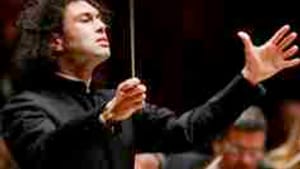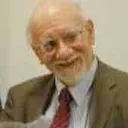Stay in the Loop
BSR publishes on a weekly schedule, with an email newsletter every Wednesday and Thursday morning. There’s no paywall, and subscribing is always free.
Cellos on the left (and what they tell us about Jurowski)
Jurowski conducts the Orchestra (3rd review)

As Steve Cohen notes in his review, Vladimir Jurowski placed the first and second violins on opposite sides of the stage, facing each other, during his latest stint with the Philadelphia Orchestra. But the most striking thing about Jurowski's seating arrangements was the fact that the cellos sat next to the first violins.
I've seen other conductors adopt this arrangement during the last few years. To modern viewers, it looks so odd as to seem eccentric. The late Max Rudolf often placed the violins opposite each other when he conducted the Concerto Soloists, but he placed the violas next to the first violins. The cellos stayed over on the audience's right, where we're accustomed to seeing them. Why in the world would anyone place them next to the first violins?
This may seem like an obscure, somewhat pedantic question, but it actually tells us something important about Jurowski's attitude toward his work. During the intermission last Thursday, I seized the chance to query one of my sources in the Orchestra and learned that this odd placement was, in fact, the standard arrangement during most of the 19th Century. The Web sources I consulted supported my source, and a conversation with a certified Ph.D. musicologist clinched the matter.
According to my source, many conductors in Europe have adapted the older arrangement and use it all the time. But Jurowski does something much more significant: He changes the seating arrangement for a particular piece to match the setup the composer would have used. Beethoven gets one seating chart, a later composer like Shostakovich gets another.
A difficult trick
This is no minor matter for a conductor. When he changes the seating arrangement, he must change his hand gestures, too. You can't cue the cellos with the same gesture, concert after concert, if they're sitting on your left one night and your right the next. Jurowski is pulling off the same trick many contemporary musicians manage when they switch from Baroque instruments to modern instruments as they hustle from concert to concert.
Jurowski is one of the "principal artists" of the Orchestra of the Age of Enlightenment— a London orchestra that plays on period instruments when appropriate, and modern instruments when it performs music created in later eras. He has obviously absorbed the basic principle of the period instrument movement: to really understand a composer's intentions, you must reproduce the sounds the composer had in mind when he heard the music in his head. The composer's score only tells us so much. We need to understand the performance practices common in his day, too.
The details of performance practice can exercise a profound influence on the impact of a piece. When the first and second violins sit side by side, we tend to hear a unified mass. When they're facing each other, we hear a dialogue— the effect many composers intended.
The older placement of the cellos affects the overall sound of the orchestra. It sounds harder and it gains horsepower.
Dedicated introvert
Steve Cohen feels Jurowski is charismatic. To me, Jurowski's public manner seems so reserved that it's almost introverted. Jurowski walks onto the stage with his head bowed and barely acknowledges the presence of the audience before he steps on the podium. He acts, to my eye, like someone who has entered the arena with his mind totally focused on the job at hand.
The sound coming out of the Orchestra reinforces that impression. The dominant characteristic of Jurowski's work is its intensity. He made three of the most popular works in the repertoire sound fresh and immediate. He conducted the Eroica like someone who understands that it's supposed to be a major event in our lives every time we hear it.
Jurowski won the support of the audience by the electricity of his work, and he seems to have earned the support of the Orchestra musicians by impressing them with the validity of his vision. If Jurowski really is the front-runner in the current search for the Orchestra's next music director, he's reached that position for the best possible reasons.♦
To read another review by Steve Cohen, click here.
To read another review by Michael Woods, click here.
I've seen other conductors adopt this arrangement during the last few years. To modern viewers, it looks so odd as to seem eccentric. The late Max Rudolf often placed the violins opposite each other when he conducted the Concerto Soloists, but he placed the violas next to the first violins. The cellos stayed over on the audience's right, where we're accustomed to seeing them. Why in the world would anyone place them next to the first violins?
This may seem like an obscure, somewhat pedantic question, but it actually tells us something important about Jurowski's attitude toward his work. During the intermission last Thursday, I seized the chance to query one of my sources in the Orchestra and learned that this odd placement was, in fact, the standard arrangement during most of the 19th Century. The Web sources I consulted supported my source, and a conversation with a certified Ph.D. musicologist clinched the matter.
According to my source, many conductors in Europe have adapted the older arrangement and use it all the time. But Jurowski does something much more significant: He changes the seating arrangement for a particular piece to match the setup the composer would have used. Beethoven gets one seating chart, a later composer like Shostakovich gets another.
A difficult trick
This is no minor matter for a conductor. When he changes the seating arrangement, he must change his hand gestures, too. You can't cue the cellos with the same gesture, concert after concert, if they're sitting on your left one night and your right the next. Jurowski is pulling off the same trick many contemporary musicians manage when they switch from Baroque instruments to modern instruments as they hustle from concert to concert.
Jurowski is one of the "principal artists" of the Orchestra of the Age of Enlightenment— a London orchestra that plays on period instruments when appropriate, and modern instruments when it performs music created in later eras. He has obviously absorbed the basic principle of the period instrument movement: to really understand a composer's intentions, you must reproduce the sounds the composer had in mind when he heard the music in his head. The composer's score only tells us so much. We need to understand the performance practices common in his day, too.
The details of performance practice can exercise a profound influence on the impact of a piece. When the first and second violins sit side by side, we tend to hear a unified mass. When they're facing each other, we hear a dialogue— the effect many composers intended.
The older placement of the cellos affects the overall sound of the orchestra. It sounds harder and it gains horsepower.
Dedicated introvert
Steve Cohen feels Jurowski is charismatic. To me, Jurowski's public manner seems so reserved that it's almost introverted. Jurowski walks onto the stage with his head bowed and barely acknowledges the presence of the audience before he steps on the podium. He acts, to my eye, like someone who has entered the arena with his mind totally focused on the job at hand.
The sound coming out of the Orchestra reinforces that impression. The dominant characteristic of Jurowski's work is its intensity. He made three of the most popular works in the repertoire sound fresh and immediate. He conducted the Eroica like someone who understands that it's supposed to be a major event in our lives every time we hear it.
Jurowski won the support of the audience by the electricity of his work, and he seems to have earned the support of the Orchestra musicians by impressing them with the validity of his vision. If Jurowski really is the front-runner in the current search for the Orchestra's next music director, he's reached that position for the best possible reasons.♦
To read another review by Steve Cohen, click here.
To read another review by Michael Woods, click here.
What, When, Where
Philadelphia Orchestra: Beethoven, Third Symphony (“Eroicaâ€); Schumann, Piano Concerto; Brahms, Tragic Overture. Vladimir Jurowski, conductor; Benedetto Lupo, piano. March 18-20, 2010 at Verizon Hall, Kimmel Center, Broad and Spruce Sts. Free pre-concert conversation 7 p.m. (215) 893-1999 or www.philorch.org.
Sign up for our newsletter
All of the week's new articles, all in one place. Sign up for the free weekly BSR newsletters, and don't miss a conversation.

 Tom Purdom
Tom Purdom